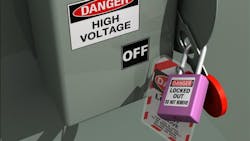Some things are just dangerous. For example, process piping. You can bump your head on it, trip over it, get burned by it, or wrench your back trying to move around it.
Generally, if you have process piping you have motor-driven pumps. Carefully scope out the process piping at and near the work location, if you're working on the related motors.
Consider that motor you're replacing. Unless it's a small motor you can easily carry, you need to plan a path for the equipment needed to extract the motor from that space. If there's not sufficient room for a lift truck, you may end up using a manual lifting device (e.g., “come along) and carry cart; those present additional hazards.
If the piping contains something that's hazardous to people or the environment, additional procedures for being in that area apply. Wear the correct personal protective equipment (PPE), conduct a visual inspection of leak points such as flanges, and know exactly what you are supposed to do in the event of a spill or leak.
About the Author

Mark Lamendola
Mark is an expert in maintenance management, having racked up an impressive track record during his time working in the field. He also has extensive knowledge of, and practical expertise with, the National Electrical Code (NEC). Through his consulting business, he provides articles and training materials on electrical topics, specializing in making difficult subjects easy to understand and focusing on the practical aspects of electrical work.
Prior to starting his own business, Mark served as the Technical Editor on EC&M for six years, worked three years in nuclear maintenance, six years as a contract project engineer/project manager, three years as a systems engineer, and three years in plant maintenance management.
Mark earned an AAS degree from Rock Valley College, a BSEET from Columbia Pacific University, and an MBA from Lake Erie College. He’s also completed several related certifications over the years and even was formerly licensed as a Master Electrician. He is a Senior Member of the IEEE and past Chairman of the Kansas City Chapters of both the IEEE and the IEEE Computer Society. Mark also served as the program director for, a board member of, and webmaster of, the Midwest Chapter of the 7x24 Exchange. He has also held memberships with the following organizations: NETA, NFPA, International Association of Webmasters, and Institute of Certified Professional Managers.
